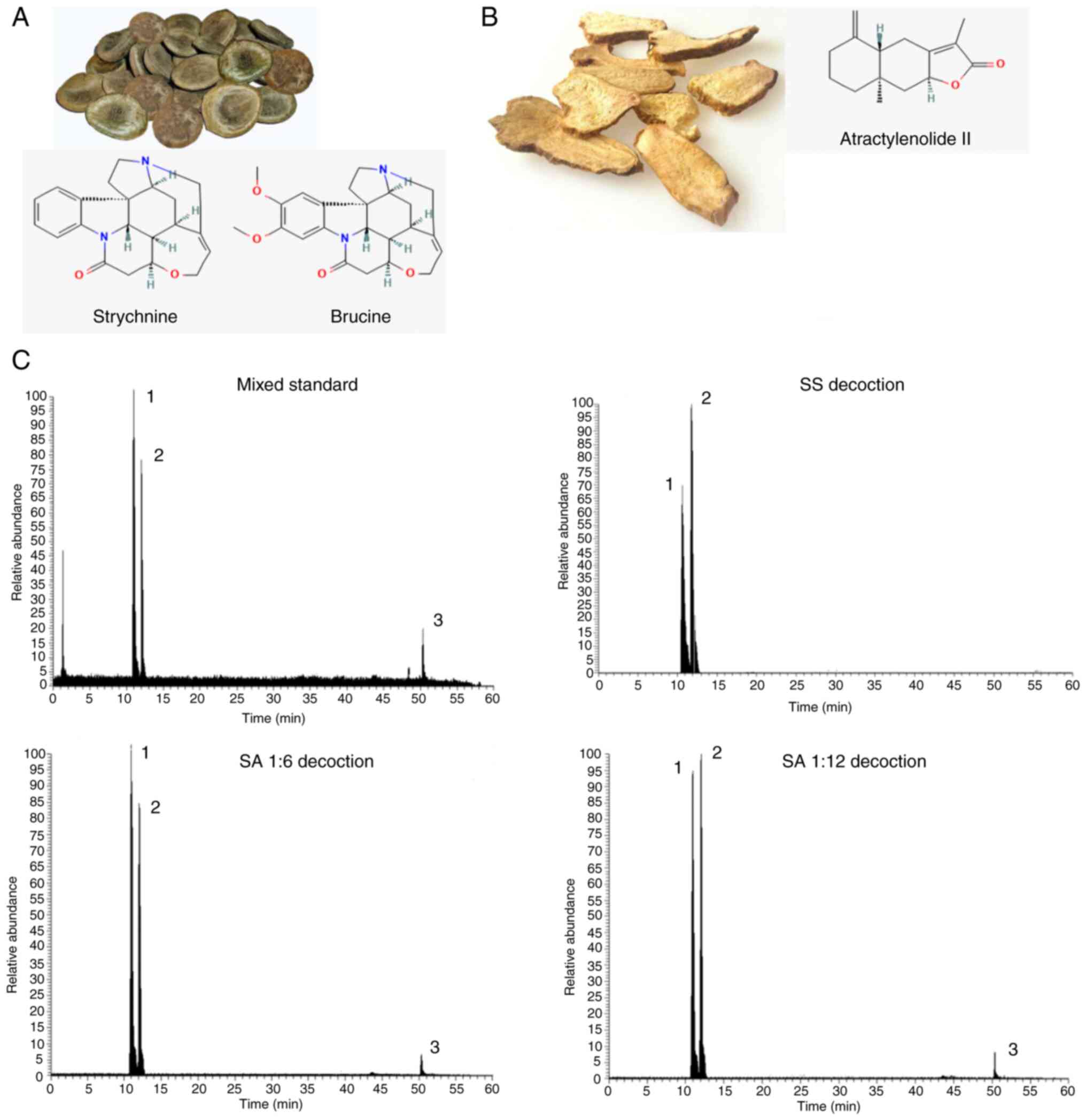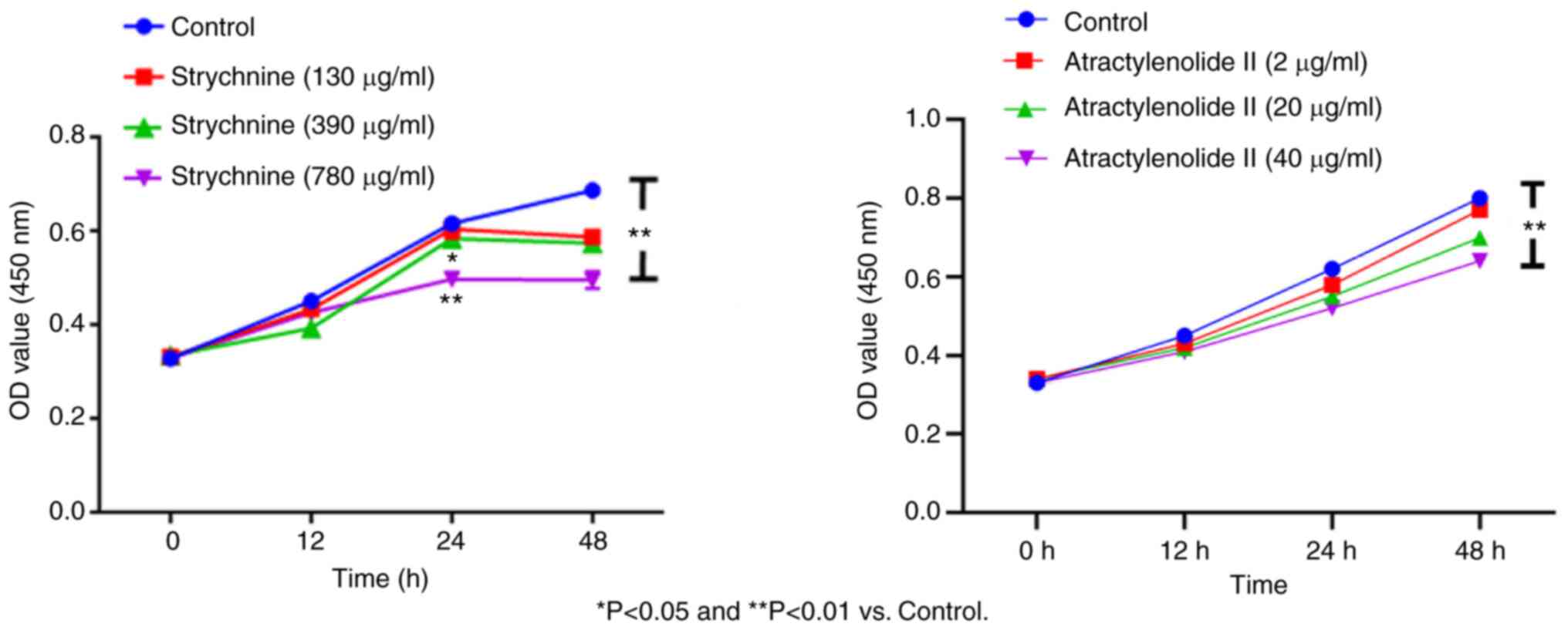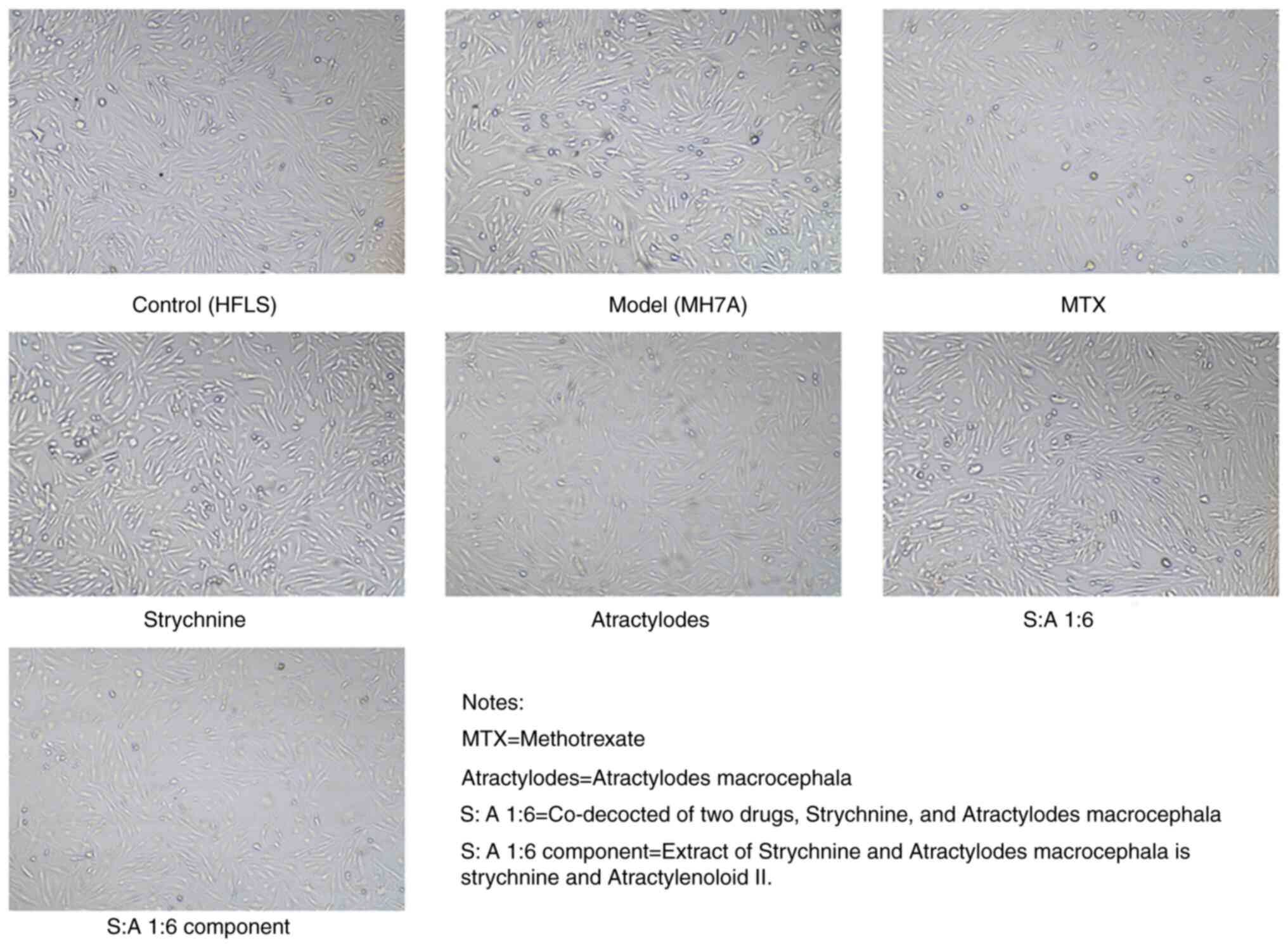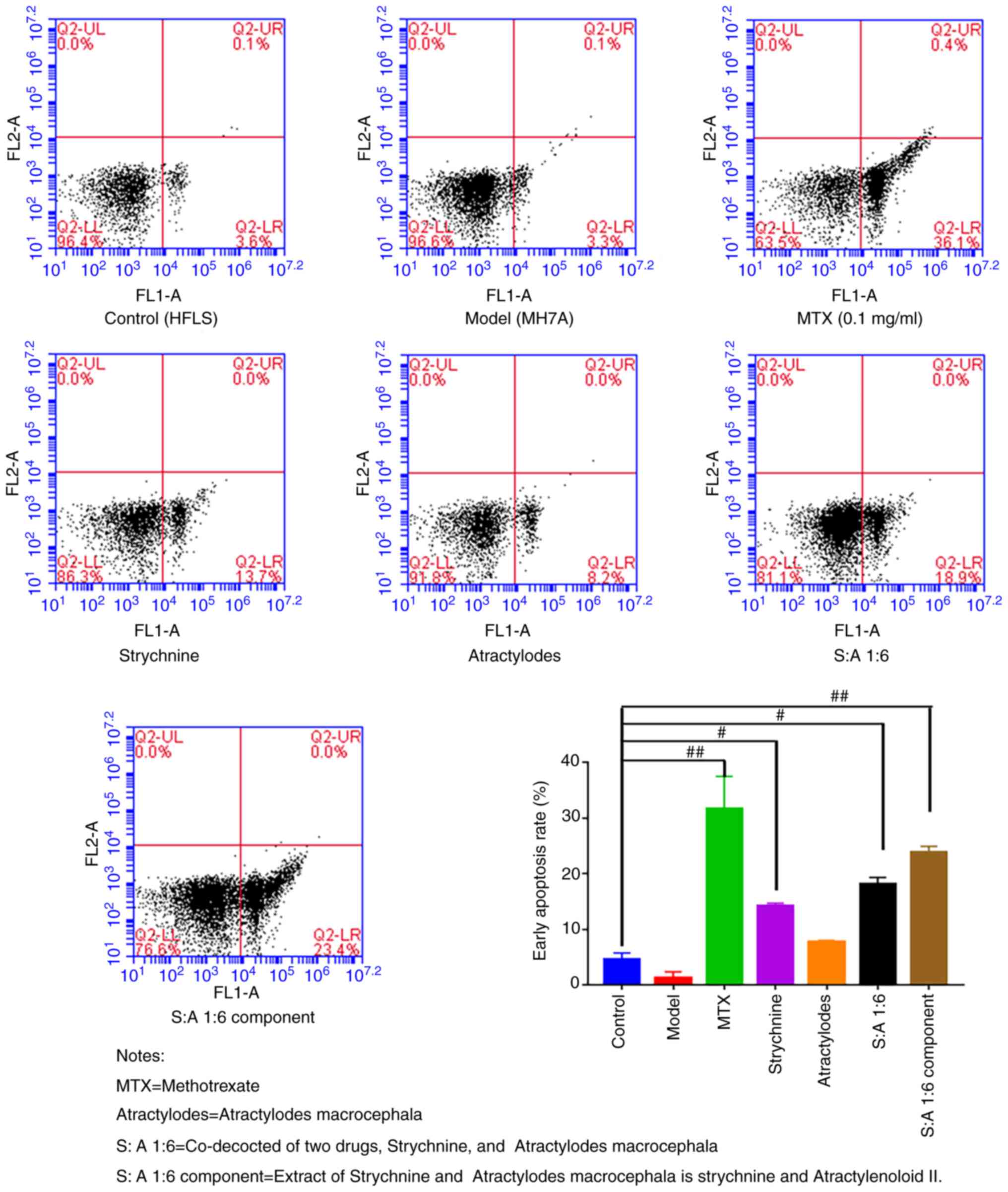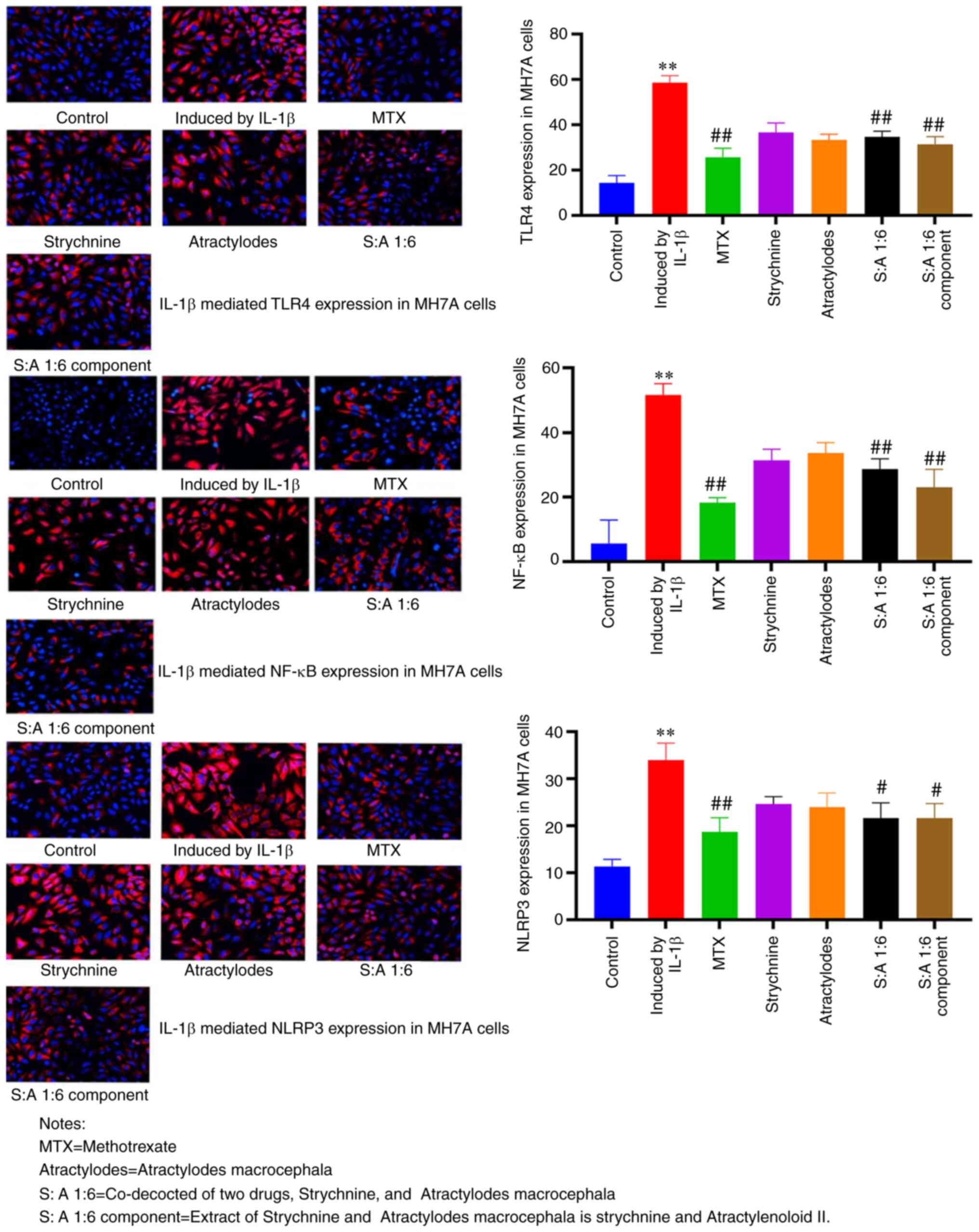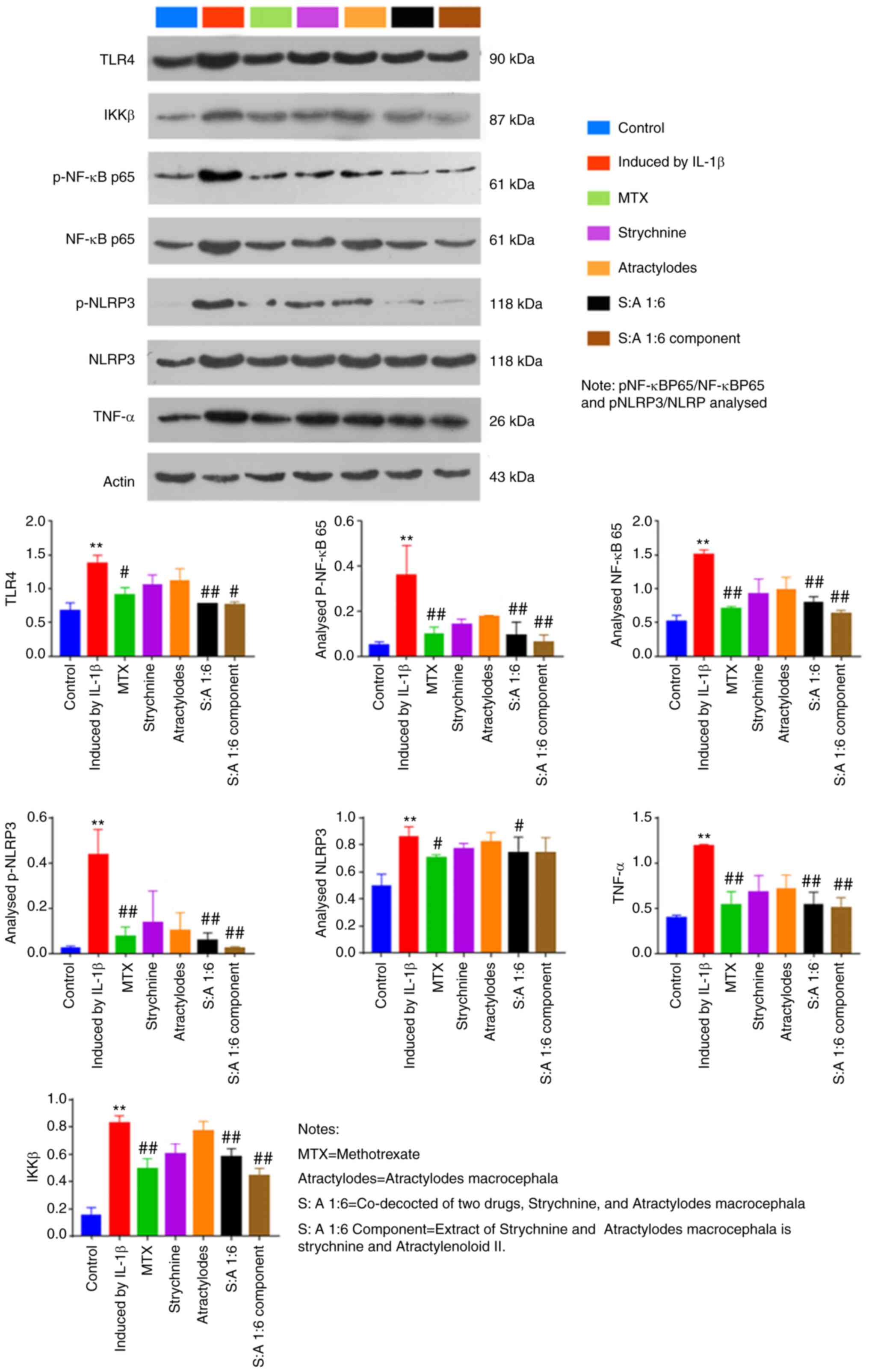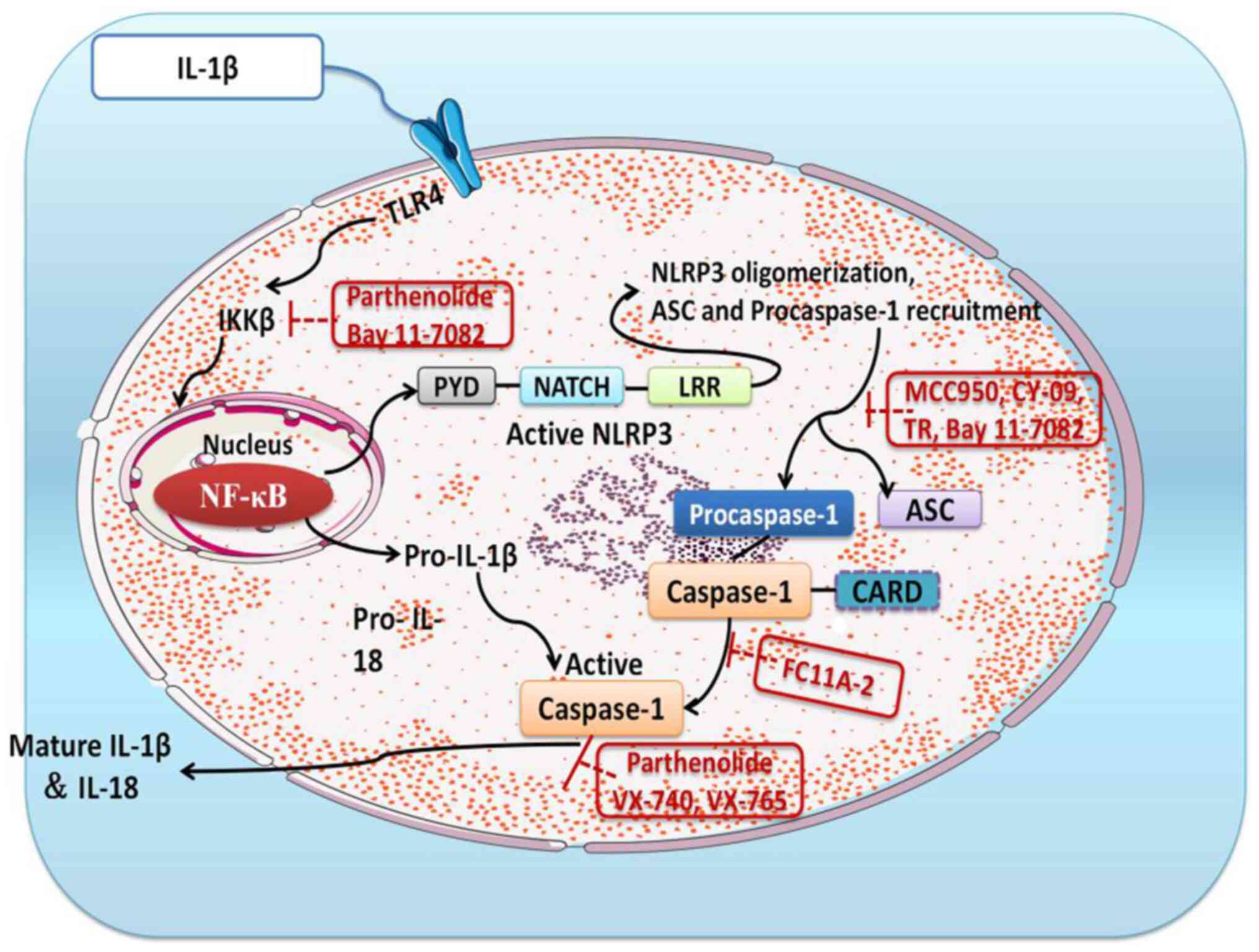|
1
|
Liu W, Zhang Y, Zhu W, Ma C, Ruan J, Long
H and Wang Y: Sinomenine inhibits the progression of rheumatoid
arthritis by regulating the secretion of inflammatory cytokines and
monocyte/macrophage subsets. Front Immunol. 9(2228)2018.PubMed/NCBI View Article : Google Scholar
|
|
2
|
Korczowska I: Rheumatoid arthritis
susceptibility genes: An overview. World J Orthop. 5:544–549.
2014.PubMed/NCBI View Article : Google Scholar
|
|
3
|
Khurana R and Berney SM: Clinical aspects
of rheumatoid arthritis. Pathophysiology. 12:153–165.
2005.PubMed/NCBI View Article : Google Scholar
|
|
4
|
Scott DL, Wolfe F and Huizinga TW:
Rheumatoid arthritis. Lancet. 376:1094–1108. 2010.PubMed/NCBI View Article : Google Scholar
|
|
5
|
Kotake S, Sato K, Kim KJ, Takahashi N,
Udagawa N, Nakamura I, Yamaguchi A, Kishimoto T, Suda T and
Kashiwazaki S: Interleukin-6 and soluble interleukin-6 receptors in
the synovial fluids from rheumatoid arthritis patients are
responsible for osteoclast-like cell formation. J Bone Miner Res.
11:88–95. 1996.PubMed/NCBI View Article : Google Scholar
|
|
6
|
Koopman FA, Chavan SS, Miljko S, Grazio S,
Sokolovic S, Schuurman PR, Mehta AD, Levine YA, Faltys M, Zitnik R,
et al: Vagus nerve stimulation inhibits cytokine production and
attenuates disease severity in rheumatoid arthritis. Proc Natl Acad
Sci USA. 113:8284–8289. 2016.PubMed/NCBI View Article : Google Scholar
|
|
7
|
Thomas R and Cope AP: Oxford textbook of
rheumatology. Oxford University Press, Oxford, UK, 2015.
|
|
8
|
McInnes IB and Schett G: The pathogenesis
of rheumatoid arthritis. N Engl J Med. 365:2205–2219.
2011.PubMed/NCBI View Article : Google Scholar
|
|
9
|
Syngle D, Singh A and Verma A: Impact of
rheumatoid arthritis on work capacity impairment and its
predictors. Clin Rheumatol. 39:1101–1109. 2020.PubMed/NCBI View Article : Google Scholar
|
|
10
|
van den Bemt BJ, Zwikker HE and van den
Ende CH: Medication adherence in patients with rheumatoid
arthritis: A critical appraisal of the existing literature. Expert
Rev Clin Immunol. 8:337–351. 2012.PubMed/NCBI View Article : Google Scholar
|
|
11
|
Korani S, Korani M, Butler AE and Sahebkar
A: Genetics and rheumatoid arthritis susceptibility in Iran. J Cell
Physiol. 234:5578–5587. 2019.PubMed/NCBI View Article : Google Scholar
|
|
12
|
Lee SY, Cho ML, Oh HJ, Ryu JG, Park MJ,
Jhun JY, Park MK, Stone JC, Ju JH, Hwang SY, et al:
Interleukin-2/anti-interleukin-2 monoclonal antibody immune complex
suppresses collagen-induced arthritis in mice by fortifying
interleukin-2/STAT5 signaling pathways. Immunology. 137:305–316.
2012.PubMed/NCBI View Article : Google Scholar
|
|
13
|
Cooles FA, Isaacs JD and Anderson AE: Treg
cells in rheumatoid arthritis: An update. Curr Rheumatol Rep.
15(352)2013.PubMed/NCBI View Article : Google Scholar
|
|
14
|
Pan F, Zhu L, Lv H and Pei C: Quercetin
promotes the apoptosis of fibroblast-like synoviocytes in
rheumatoid arthritis by upregulating lncRNA MALAT1. Int J Mol Med.
38:1507–1514. 2016.PubMed/NCBI View Article : Google Scholar
|
|
15
|
Yang J, Zhao F and Nie J: Anti-rheumatic
effects of Aconitum leucostomum Worosch. On human fibroblast-like
synoviocyte rheumatoid arthritis cells. Exp Ther Med. 14:453–460.
2017.PubMed/NCBI View Article : Google Scholar
|
|
16
|
McInnes IB and Schett G: Pathogenetic
insights from the treatment of rheumatoid arthritis. Lancet.
389:2328–2337. 2017.PubMed/NCBI View Article : Google Scholar
|
|
17
|
Zhu YG and Qu JM: Toll like receptors and
inflammatory factors in sepsis and differential expression related
to age. Chin Med J (Engl). 120:56–61. 2007.PubMed/NCBI
|
|
18
|
Qing YF, Zhang QB, Zhou JG and Jiang L:
Changes in toll-like receptor (TLR)4-NFκB-IL1β signaling in male
gout patients might be involved in the pathogenesis of primary
gouty arthritis. Rheumatol Int. 34:213–220. 2014.PubMed/NCBI View Article : Google Scholar
|
|
19
|
Chang YY, Jean WH, Lu CW, Shieh JS, Chen
ML and Lin TY: Nicardipine inhibits priming of the NLRP3
inflammasome via suppressing LPS-induced TLR4 expression.
Inflammation. 43:1375–1386. 2020.PubMed/NCBI View Article : Google Scholar
|
|
20
|
Martinon F, Burns K and Tschopp J: The
inflammasome: A molecular platform triggering activation of
inflammatory caspases and processing of proIL-beta. Mol Cell.
10:417–426. 2002.PubMed/NCBI View Article : Google Scholar
|
|
21
|
Agostini L, Martinon F, Burns K, McDermott
MF, Hawkins PN and Tschopp J: NALP3 forms an IL-1beta-processing
inflammasome with increased activity in Muckle-Wells
autoinflammatory disorder. Immunity. 20:319–325. 2004.PubMed/NCBI View Article : Google Scholar
|
|
22
|
Schroder K and Tschopp J: The
inflammasomes. Cell. 140:821–832. 2010.PubMed/NCBI View Article : Google Scholar
|
|
23
|
Strowig T, Henao-Mejia J, Elinav E and
Flavell R: Inflammasomes in health and disease. Nature.
481:278–286. 2012.PubMed/NCBI View Article : Google Scholar
|
|
24
|
Xu XY, Cai BC, Pan Y and Wang TS:
Pharmacokinetics of the alkaloids from the processed seeds of
Strychnos nux-vomica in rats. Yao Xue Xue Bao. 38:458–461.
2003.PubMed/NCBI(In Chinese).
|
|
25
|
Tang M, Zhu WJ, Yang ZC and He CS: Brucine
inhibits TNF-α-induced HFLS-RA cell proliferation by activating the
JNK signaling pathway. Exp Ther Med. 18:735–740. 2019.PubMed/NCBI View Article : Google Scholar
|
|
26
|
Shu G, Mi X, Cai J, Zhang X, Yin W, Yang
X, Li Y, Chen L and Deng X: Brucine, an alkaloid from seeds of
Strychnos nux-vomica Linn., represses hepatocellular
carcinoma cell migration and metastasis: The role of hypoxia
inducible factor 1 pathway. Toxicol Lett. 222:91–101.
2013.PubMed/NCBI View Article : Google Scholar
|
|
27
|
Rao PS and Prasad MN: Strychnos
nux-vomica root extract induces apoptosis in the human multiple
myeloma cell line-U266B1. Cell Biochem Biophys. 66:443–450.
2013.PubMed/NCBI View Article : Google Scholar
|
|
28
|
Chen J, Qu Y, Wang D, Peng P, Cai H, Gao
Y, Chen Z and Cai B: Pharmacological evaluation of total alkaloids
from nux vomica: Effect of reducing strychnine contents. Molecules.
19:4395–4408. 2014.PubMed/NCBI View Article : Google Scholar
|
|
29
|
Li Y, Liu Y, Shao Y, Zhang F, Liu W, Liang
X and Chen L: Mechanism of action of strychni semen for treating
rheumatoid arthritis and methods for attenuating the toxicity. Comb
Chem High Throughput Screen. 25:587–606. 2022.PubMed/NCBI View Article : Google Scholar
|
|
30
|
Guo R, Wang T, Zhou G, Xu M, Yu X, Zhang
X, Sui F, Li C, Tang L and Wang Z: Botany, phytochemistry,
pharmacology and toxicity of Strychnos nux-vomica L.: A
review. Am J Chin Med. 46:1–23. 2018.PubMed/NCBI View Article : Google Scholar
|
|
31
|
Qin JM, Yin PH, Li Q, Sa ZQ, Sheng X, Yang
L, Huang T, Zhang M, Gao KP, Chen QH, et al: Anti-tumor effects of
brucine immuno-nanoparticles on hepatocellular carcinoma. Int J
Nanomedicine. 7:369–379. 2012.PubMed/NCBI View Article : Google Scholar
|
|
32
|
Chen J, Hou T, Fang Y, Chen ZP, Liu X, Cai
H, Lu TL, Yan GJ and Cai BC: HPLC determination of strychnine and
brucine in rat tissues and the distribution study of processed
semen strychni. Yakugaku Zasshi. 131:721–729. 2011.PubMed/NCBI View Article : Google Scholar
|
|
33
|
Dai J, Liu J, Zhang M, Yu Y and Wang J:
Network toxicology and molecular docking analyses on strychnine
indicate CHRM1 is a potential neurotoxic target. BMC Complement Med
Ther. 22(273)2022.PubMed/NCBI View Article : Google Scholar
|
|
34
|
Otter J and D'Orazio JL: Strychnine
toxicity. In: StatPearls [Internet]. Treasure Island (FL):
StatPearls Publishing, 2022.
|
|
35
|
Lu L, Huang R, Wu Y, Jin JM, Chen HZ,
Zhang LJ and Luan X: Brucine: A review of phytochemistry,
pharmacology, and toxicology. Front Pharmacol.
11(377)2020.PubMed/NCBI View Article : Google Scholar
|
|
36
|
Zhao C, Li E, Wang Z, Tian J, Dai Y, Ni Y,
Li F, Ma Z and Lin R: Nux vomica exposure triggered liver injury
and metabolic disturbance in zebrafish larvae. Zebrafish.
15:610–628. 2018.PubMed/NCBI View Article : Google Scholar
|
|
37
|
Fan Y, Liu S, Chen X, Feng M, Song F and
Gao X: Toxicological effects of nux vomica in rats urine and serum
by means of clinical chemistry, histopathology and 1H
NMR-based metabonomics approach. J Ethnopharmacol. 210:242–253.
2018.PubMed/NCBI View Article : Google Scholar
|
|
38
|
Li Y, Wang J, Xiao Y, Wang Y, Chen S, Yang
Y, Lu A and Zhang S: A systems pharmacology approach to investigate
the mechanisms of action of semen strychni and Tripterygium
wilfordii Hook F for treatment of rheumatoid arthritis. J
Ethnopharmacol. 175:301–314. 2015.PubMed/NCBI View Article : Google Scholar
|
|
39
|
Lü D, Jiang Q, Zhang J, Zeng R, Liao Z and
Liang X: Effect of baizhu (rhizoma atractylodis macrocephalae)
extract on intestinal absorption of brucine and strychnine in vitro
and in situ. J Tradit Chin Med. 40:562–570. 2020.PubMed/NCBI View Article : Google Scholar
|
|
40
|
Emery P, Breedveld FC, Hall S, Durez P,
Chang DJ, Robertson D, Singh A, Pedersen RD, Koenig AS and
Freundlich B: Comparison of methotrexate monotherapy with a
combination of methotrexate and etanercept in active, early,
moderate to severe rheumatoid arthritis (COMET): A randomised,
double-blind, parallel treatment trial. Lancet. 372:375–382.
2008.PubMed/NCBI View Article : Google Scholar
|
|
41
|
Friedman B and Cronstein B: Methotrexate
mechanism in treatment of rheumatoid arthritis. Joint Bone Spine.
86:301–307. 2019.PubMed/NCBI View Article : Google Scholar
|
|
42
|
Alarcón GS, Tracy IC and Blackburn WJ Jr:
Methotrexate in rheumatoid arthritis. Toxic effects as the major
factor in limiting long-term treatment. Arthritis Rheum.
32:671–676. 1989.PubMed/NCBI View Article : Google Scholar
|
|
43
|
Yu Z, Liu H, Fan J, Chen F and Liu W:
MicroRNA-155 participates in the expression of LSD1 and
proinflammatory cytokines in rheumatoid synovial cells. Mediators
Inflame. 2020(4092762)2020.PubMed/NCBI View Article : Google Scholar
|
|
44
|
Livak KJ and Schmittgen TD: Analysis of
relative gene expression data using real-time quantitative PCR and
the 2(-Delta Delta C(T)) method. Methods. 25:402–408.
2001.PubMed/NCBI View Article : Google Scholar
|
|
45
|
Brunelle JL and Green R: Coomassie blue
staining. Methods Enzymol. 541:161–167. 2014.PubMed/NCBI View Article : Google Scholar
|
|
46
|
Dörner T, Vital EM, Ohrndorf S, Alten R,
Bello N, Haladyj E and Burmester G: A narrative literature review
comparing the key features of musculoskeletal involvement in
rheumatoid arthritis and systemic lupus erythematosus. Rheumatol
Ther. 9:781–802. 2022.PubMed/NCBI View Article : Google Scholar
|
|
47
|
Radu AF and Bungau SG: Management of
rheumatoid arthritis: An overview. Cells. 10(2857)2021.PubMed/NCBI View Article : Google Scholar
|
|
48
|
Chauhan K, Jandu JS, Goyal A and Al-Dhahir
MA: Rheumatoid arthritis. In: StatPearls. StatPearls Publishing,
Treasure Island, FL, 2022.
|
|
49
|
Zhong Y, Lai D, Zhang L, Lu W, Shang Y and
Zhou H: The effects of moxibustion on PD-1/PD-L1-related molecular
expression and inflammatory cytokine levels in RA rats. Evid Based
Complement Alternat Med. 2021(6658946)2021.
|
|
50
|
Li S, Chu Y, Zhang R, Sun L and Chen X:
Prophylactic neuroprotection of total glucosides of paeoniae radix
alba against semen strychni-induced neurotoxicity in rats:
Suppressing oxidative stress and reducing the absorption of toxic
components. Nutrients. 10(514)2018.PubMed/NCBI View Article : Google Scholar
|
|
51
|
Tong HF, Chan CY, Ng SW and Mak TWL:
Strychnine poisoning due to traditional Chinese medicine: A case
series. F1000Res. 10(924)2021.PubMed/NCBI View Article : Google Scholar
|
|
52
|
Cao B, Wang T, Qu Q, Kang T and Yang Q:
Long noncoding RNA SNHG1 promotes neuroinflammation in Parkinson's
disease via regulating miR-7/NLRP3 pathway. Neuroscience.
388:118–127. 2018.PubMed/NCBI View Article : Google Scholar
|
|
53
|
Bachmaier K, Toya S, Gao X, Triantafillou
T, Garrean S, Park GY, Frey RS, Vogel S, Minshall R, Christman JW,
et al: E3 ubiquitin ligase Cblb regulates the acute inflammatory
response underlying lung injury. Nat Med. 13:920–926.
2007.PubMed/NCBI View
Article : Google Scholar
|
|
54
|
Xiang P, Chen T, Mou Y, Wu H, Xie P, Lu G,
Gong X, Hu Q, Zhang Y and Ji H: NZ suppresses TLR4/NF-κB signalings
and NLRP3 inflammasome activation in LPS-induced RAW264.7
macrophages. Inflamm Res. 64:799–808. 2015.PubMed/NCBI View Article : Google Scholar
|
|
55
|
Pålsson-McDermott EM and O'Neill LAJ:
Signal transduction by the lipopolysaccharide receptor, Toll-like
receptor-4. Immunology. 113:153–162. 2004.PubMed/NCBI View Article : Google Scholar
|
|
56
|
Wang Y, Cui Y, Cao F, Qin Y, Li W and
Zhang J: Ganglioside GD1a suppresses LPS-induced pro-inflammatory
cytokines in RAW264.7 macrophages by reducing MAPKs and NF-κB
signaling pathways through TLR4. Int Immunopharmacol. 28:136–145.
2015.PubMed/NCBI View Article : Google Scholar
|
|
57
|
Malik A and Kanneganti TD: Function and
regulation of IL-1α in inflammatory diseases and cancer. Immunol
Rev. 281:124–137. 2018.PubMed/NCBI View Article : Google Scholar
|
|
58
|
Zusso M, Lunardi V, Franceschini D,
Pagetta A, Lo R, Stifani S, Frigo AC, Giusti P and Moro S:
Ciprofloxacin and levofloxacin attenuate microglia inflammatory
response via TLR4/NF-kB pathway. J Neuroinflammation.
16(148)2019.PubMed/NCBI View Article : Google Scholar
|
|
59
|
Wu XL, Liou CJ, Li ZY, Lai XY, Fang LW and
Huang WC: Sesamol suppresses the inflammatory response by
inhibiting NF-κB/MAPK activation and upregulating AMP kinase
signaling in RAW 264.7 macrophages. Inflamm Res. 64:577–588.
2015.PubMed/NCBI View Article : Google Scholar
|
|
60
|
Antonia RJ, Hagan RS and Baldwin AS:
Expanding the view of IKK: New substrates and new biology. Trends
Cell Biol. 31:166–178. 2021.PubMed/NCBI View Article : Google Scholar
|
|
61
|
Wu J and Chen ZJ: Innate immune sensing
and signaling of cytosolic nucleic acids. Annu Rev Immunol.
32:461–488. 2014.PubMed/NCBI View Article : Google Scholar
|
|
62
|
Helgason E, Phung QT and Dueber EC: Recent
insights into the complexity of Tank-binding kinase 1 signaling
networks: the emerging role of cellular localization in the
activation and substrate specificity of TBK1. FEBS Lett.
587:1230–1237. 2013.PubMed/NCBI View Article : Google Scholar
|
|
63
|
Di Rita A, Peschiaroli A, D Acunzo P,
Strobbe D, Hu Z, Gruber J, Nygaard M, Lambrughi M, Melino G,
Papaleo E, et al: HUWE1 E3 ligase promotes PINK1/PARKIN-independent
mitophagy by regulating AMBRA1 activation via IKKα. Nat Commun.
9(3755)2018.PubMed/NCBI View Article : Google Scholar
|
|
64
|
Takeuchi O and Akira S: Pattern
recognition receptors and inflammation. Cell. 140:805–820.
2010.PubMed/NCBI View Article : Google Scholar
|
|
65
|
Lamkanfi M and Dixit VM: Mechanisms and
functions of inflammasomes. Cell. 157:1013–1022. 2014.PubMed/NCBI View Article : Google Scholar
|
|
66
|
Sharma D and Kanneganti TD: The cell
biology of inflammasomes: Mechanisms of inflammasome activation and
regulation. J Cell Biol. 213:617–629. 2016.PubMed/NCBI View Article : Google Scholar
|
|
67
|
Li Z, Guo J and Bi L: Role of the NLRP3
inflammasome in autoimmune diseases. Biomed Pharmacother.
130(110542)2020.PubMed/NCBI View Article : Google Scholar
|
|
68
|
Mangan MSJ, Olhava EJ, Roush WR, Seidel
HM, Glick GD and Latz E: Targeting the NLRP3 inflammasome in
inflammatory diseases. Nat Rev Drug Discov. 17:588–606.
2018.PubMed/NCBI View Article : Google Scholar
|
|
69
|
Shao BZ, Xu ZQ, Han BZ, Su DF and Liu C:
NLRP3 inflammasome and its inhibitors: A review. Front Pharmacol.
6(262)2015.PubMed/NCBI View Article : Google Scholar
|
|
70
|
Luo YP, Jiang L, Kang K, Fei DS, Meng XL,
Nan CC, Pan SH, Zhao MR and Zhao MY: Hemin inhibits NLRP3
inflammasome activation in sepsis-induced acute lung injury,
involving heme oxygenase-1. Int Immunopharmacol. 20:24–32.
2014.PubMed/NCBI View Article : Google Scholar
|
|
71
|
Sun L, Ma W, Gao W, Xing Y, Chen L, Xia Z,
Zhang Z and Dai Z: Propofol directly induces caspase-1-dependent
macrophage pyroptosis through the NLRP3-ASC inflammasome. Cell
Death Dis. 10(542)2019.PubMed/NCBI View Article : Google Scholar
|
|
72
|
Chao LK, Lin CH, Chiu HW, Wong WT, Chiu
HW, Tasi YL, Kuo YH, Chiu YC, Liu ML, Ho CL and Hua KF:
Peroxyauraptenol inhibits inflammation and NLRP3 inflammasome
activation by inhibiting reactive oxygen species generation and
preserving mitochondrial integrity. J Agric Food Chem.
63:1210–1219. 2015.PubMed/NCBI View Article : Google Scholar
|
|
73
|
Lee J, Rhee MH, Kim E and Cho JY: BAY
11-7082 is a broad-spectrum inhibitor with anti-inflammatory
activity against multiple targets. Mediators Inflamm.
2012(416036)2012.PubMed/NCBI View Article : Google Scholar
|
|
74
|
Xia ZB, Meng FR, Fang YX, Wu X, Zhang CW,
Liu Y, Liu D, Li GQ, Feng FB and Qiu HY: Inhibition of NF-κB
signaling pathway induces apoptosis and suppresses proliferation
and angiogenesis of human fibroblast-like synovial cells in
rheumatoid arthritis. Medicine (Baltimore).
97(e10920)2018.PubMed/NCBI View Article : Google Scholar
|
|
75
|
Zahid A, Li B, Kombe AJK, Jin T and Tao J:
Pharmacological inhibitors of the NLRP3 inflammasome. Front
Immunol. 10(2538)2019.PubMed/NCBI View Article : Google Scholar
|















